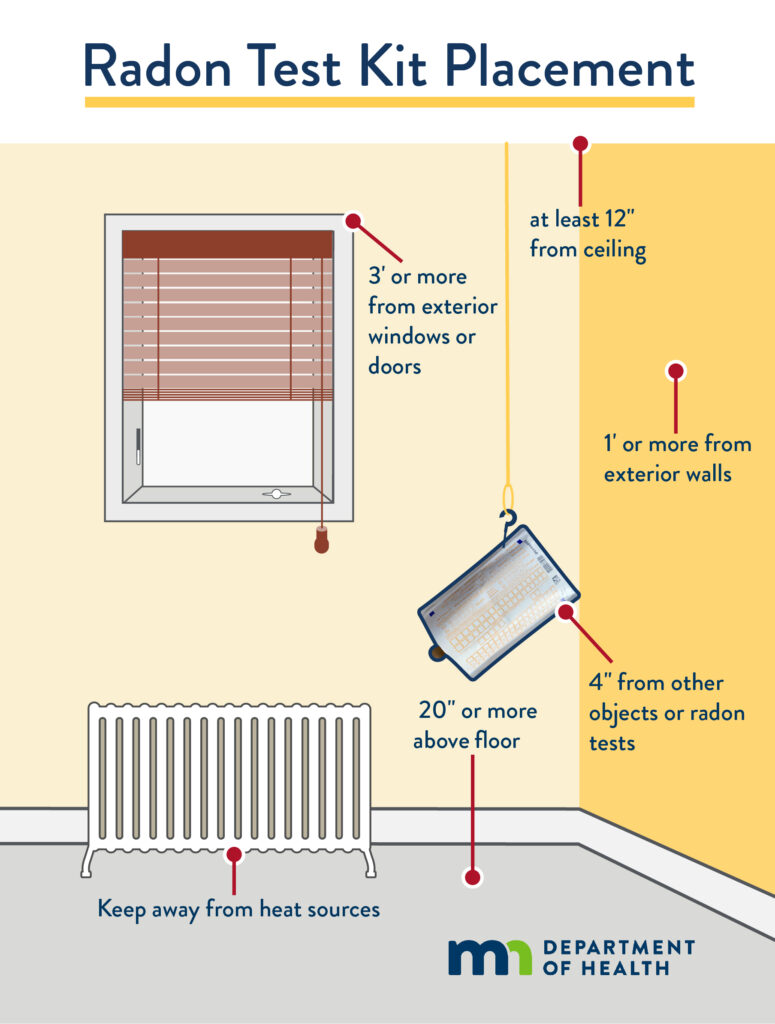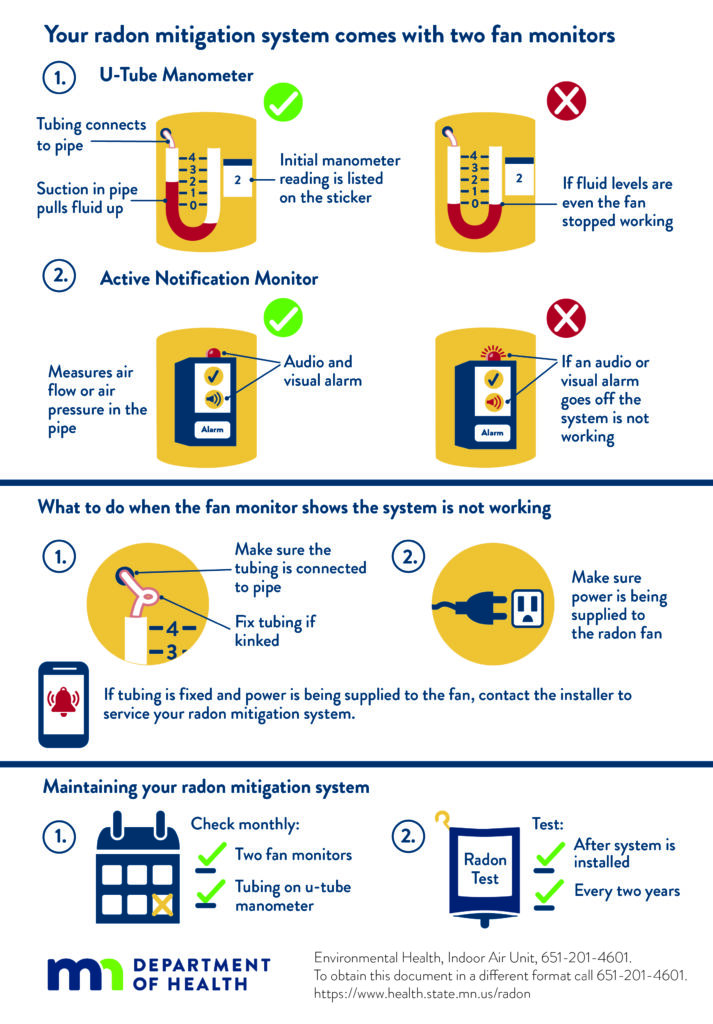Radon in your home can be a serious problem. Radon is the number one cause of lung cancer among non-smokers, according to EPA estimates. Overall, radon is the second leading cause of lung cancer and is responsible for about 21,000 lung cancer deaths every year. About 2,900 of these deaths occur among people who have never smoked.
Two studies, a North American study and a European study, combined data from several previous residential studies. These two studies go a step beyond earlier findings. They confirm the radon health risks predicted by occupational studies of underground miners who breathed radon for a period of years.
ABOUT NRPP CERTIFICATION
The Environmental Protection Agency of the US Government recognizes only two Radon Certification companies – The NRPP and the NRSB. Standard Water Control Systems is an NRPP Certified Radon Mitigation Company.
The NRPP is an independent administrative program of the American Association of Radon Scientists and Technologists, Inc. (AARST), the NRPP holds the ISO 17024 ANSI accreditation and is governed by a Certification Council consisting of radon industry stakeholders who are responsible for credentialing policies and procedures.
Standard Water is a Certified Radon Mitigation Specialist. The NRPP Radon Mitigation Specialist Certification is for those who evaluate radon measurements and design and install radon remediation systems. A Radon Mitigation Specialist is responsible for the implementation, execution, and documentation of all required Quality Management and Worker Safety procedures and may provide general supervision Radon Mitigation Installers within the same company.
To obtain this two-year certification, the National Radon Proficiency Program requires:
- Completion of a 16-hour Radon Measurement Professional Initial Training Course from an approved training provider as a prerequisite
- Completion of a 24-hour Radon Mitigation Specialist Exam-Prep Course from an approved training provider
- Passing score on the NRPP Mitigation Specialist Exam
- 16 hours of continuing education biennially
- Adherence to the NRPP Code of Ethics & Certification Terms
This is important because you want the highest quality mitigation possible from the most educated and experienced professionals when we’re talking about the safety of the people in your home.
DETERMINE IF RADON IS A PROBLEM IN YOUR HOME
When dealing with Radon the first thing you need to do is find out if it’s a problem in your home. This requires a test to be performed. It only takes a few days. The critical part of testing is interpreting the results. Standard is happy to provide you with a free Radon Test Kit and will interpret the results along with you. If your home does have elevated radon levels, we have the knowledge, skill, and experience to install a Radon Mitigation System.

USE A CERTIFIED RADON CONTRACTOR
The Environmental Protection Agency recommends you use a certified or qualified radon mitigation contractor trained to fix radon problems. You can determine a service provider’s qualifications to perform radon measurements or to mitigate your home in several ways. First, check with your state radon office. Many states require radon professionals to be licensed, certified or registered, and to install radon mitigation systems that meet state requirements. Most states can provide you with a list of knowledgeable radon service providers doing business in the state (https://www.epa.gov/radon/find-information-about-local-radon-zones-andstate-contact-information).
CHOOSING A RADON MITIGATION CONTRACTOR
Choose a contractor to fix a radon problem just as you would choose someone to do other home repairs. It is wise to get more than one estimate, to ask for references, and to contact some of those references to ask if they are satisfied with the contractor’s work.
Compare the contractor’s proposed costs and consider what you get for your money, taking into account: a less expensive system may cost more to operate and maintain; a less expensive system may have less aesthetic appeal; a more expensive system may be best for your home; and, the quality of the building material will affect how long the system lasts.

Make sure the contractors proposals include:
- Proof of state certification, professional proficiency or certification credentials
- Proof of liability insurance and being bonded, and having all necessary licenses to satisfy local requirements
- Diagnostic testing prior to design and installation of a radon reduction system
- Installation of a warning device to caution you if the radon reduction system is not working correctly
- Testing after installation to make sure the radon reduction system works well
- A guarantee to reduce radon levels to 4 pCi/L or below? And if so, for how long?
Ask the contractor to prepare a contract before any work starts. Read the contract before you sign it. Make sure everything in the contract matches the original proposal. The contract should describe exactly what work will be done prior to and during the installation of the system, what the system consists of, and how the system will operate. Many contractors provide a guarantee that they will adjust or modify the system to reach a negotiated radon level (e.g., 2 pCi/L or less). Carefully read the conditions of the contract describing the guarantee. Consider optional additions to your contract that may add to the initial cost of the system, but may be worth the extra expense. Typical options might include an extended warranty, a service plan or improved aesthetics.
Most types of radon reduction systems cause some loss of heated or air conditioned air, which could increase your utility bills. How much your utility bills increase will depend on the climate you live in, what kind of reduction system you select, and how your home is built. Systems that use fans are more effective in reducing radon levels; however, they will slightly increase your electric bill.
METHODS FOR REDUCING RADON
There are several methods a contractor can use to lower radon levels in your home. Some techniques prevent radon from entering your home while others reduce radon levels after it has entered. EPA generally recommends methods that prevent the entry of radon. Soil suction, for example, prevents radon from entering your home by drawing the radon from below the home and venting it through a pipe, or pipes, to the air above the home where it is quickly diluted.
In homes that have a basement or a slab-on-grade foundation, radon is usually reduced by one of four types of soil suction: subslab suction, drain-tile suction, sump-hole suction, or block-wall suction.
Active subslab suction — also called subslab depressurization — is the most common and usually the most reliable radon reduction method. One or more suction pipes are inserted through the floor slab into the crushed rock or soil underneath. They also may be inserted below the concrete slab from outside the home. The number and location of suction pipes that are needed depends on how easily air can move in the crushed rock or soil under the slab and on the strength of the radon source. Often, only a single suction point is needed.

Here is a list of basic installation requirements that your contractor should meet when installing a radon reduction system in your home. It is important to verify with your contractor that the radon mitigation standards (ASTM E2121 in particular) are properly met to ensure that your radon reduction system will be effective. You also can check with your state radon office to see if there are state requirements that your contractor must meet.
- Radon reduction systems must be clearly labeled. This will avoid accidental changes to the system that could disrupt its function.
- The exhaust pipes of soil suction systems must vent above the surface of the roof and 10 feet or more above the ground, and must be at least 10 feet away from windows, doors or other openings that could allow radon to reenter the home, if the exhaust pipes do not vent at least 2 feet above these openings.
- The exhaust fan must not be located in or below a livable area. For instance, it should be installed in unconditioned space. If installing an exhaust fan outside, the contractor must install a fan that meets local building codes for exterior use.
- Electrical connections of all active radon reduction systems must be installed according to local electrical codes.
- A warning device must be installed to alert you if an active system stops working properly. Examples of system failure warning devices are: a liquid gauge, a sound alarm, a light indicator, and a dial, or needle display, gauge. The warning device must be placed where it can be seen or heard easily. Your contractor should check that the warning device works. Later on, if your monitor shows that the system is not working properly, call a contractor to have it checked.
- A post-mitigation radon test should be done within 30 days of system installation, but no sooner than 24 hours after your system is in operation with the fan on, if it has one. The contractor may perform a post-mitigation test to check his work and the initial effectiveness of the system; however, it is recommended that you also get an independent follow-up radon measurement. Having an independent tester perform the test, or conducting the measurement yourself, will eliminate any potential conflict of interest. To test the system’s effectiveness, a two- to seven-day measurement is recommended. Test conditions: windows and doors must be closed 12 hours before and during the test, except for normal entry and exit.
- Make sure your contractor completely explains your radon reduction system, demonstrates how it operates and explains how to maintain it. Ask for written operating and maintenance instructions and copies of any warranties.
A WORD ABOUT RADON MITIGATION SYSTEM MAINTENANCE
Similar to a furnace or chimney, radon reduction systems need occasional maintenance. If you have a fan powered (or active) system, you should look at your warning device, usually a manometer, on a regular basis to make sure the system is working correctly. Fans may last for five years or more — manufacturer warranties tend not to exceed five years — and may then need to be repaired or replaced. The cost to replace a fan varies as it is based on labor and materials. Ask qualified mitigators for estimates before work begins. It is a good idea to retest your home at least every two years to be sure radon levels remain low. Remember, the fan should NEVER be turned off; it must run continuously for the system to work correctly.
FINALLY
If you have any questions regarding your home and Radon, please do not hesitate to contact Standard Water. We’re more than happy to provide you with a free Radon Test Kit and consult with you to discuss what the results mean to you. If it turns out you have elevated levels of Radon, we can also offer a free, no obligation estimate to help reduce those levels. Contact us today.
For More info: https://standardwater.com/services/radon-mitigation/
